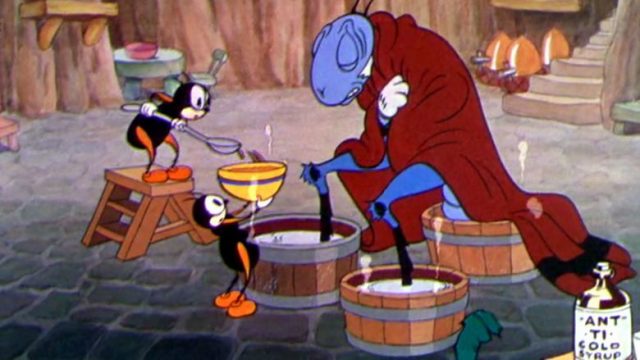Grasshoppers hold two basic places in Western culture. One is as the enormous force of destruction exemplified in, for example, On the Banks of Plum Creek. Laura Ingalls Wilder told of the devastation of her family’s hopes after a swarm of the now-extinct Rocky Mountain grasshopper at everything for miles. In some places, locusts have even eaten the clothes off people’s backs. (Locusts are the swarming form of certain species of grasshopper. And now you know.) Any number of famines throughout human history have been caused by grasshoppers. It’s one of those curious instances of a species generally thought harmless having actually caused unknown numbers of deaths throughout history.
On the other hand, there’s this. A grasshopper (Pinto Colvig) plays the fiddle and sings cheerfully about how the world owes him a living. Meanwhile, the ants work, gathering food and storing it up against winter. He gets an ant to stop working and start dancing. The Ant Queen disapproves. The grasshopper goes on his way. Winter comes, and the grasshopper is freezing and starving; meanwhile, the ants live in warmth and comfort and are all well fed. Because working and planning for the future makes more sense than assuming everything will work out for you in the long run and not planning for it.
Okay, so adult grasshoppers live less than two months in their final stage of development. This grasshopper could live in a climate where there was warmth and food year round, and it wouldn’t keep him alive through an entire winter. One assumes that Aesop didn’t know much about the life cycle of grasshoppers, after all, and the story isn’t changing just because we know more about entomology than we used to. (Specifically “acridology,” if you’re interested in just grasshoppers.) The thing about a fable is that it doesn’t have to be true to life—neither ants nor grasshoppers talk, after all.
Of course, the cartoon insects aren’t exactly entomologically correct. (The study of ants is “myrmecology.”) Disney’s ants have been drawn in any number of fashions over the decades, and these are . . . not bad, as Disney ants go. Black, yes, because ants. With white faces—sort of ant versions of Mickey, really. But these ants aren’t any kind of crude “native” stereotype, which they will be in at least one later cartoon. And the ant queen even gets a fancy dress—and the ants get a queen, come to that.
Many Silly Symphonies were based on fairy tales or Aesop’s fables or similar. The next year would see “The Wise Little Hen,” based on a Russian folktale and the first appearance of Donald Duck, Aquatic Sociopath. This short didn’t have quite the same level of influence. But the grasshopper has definite Goofy characteristics, and of course “The World Owes Me a Living” would be Goofy’s unofficial theme for years to come. It’s also, it seems, one of the first appearances of a cartoon character literally turning blue from cold, because the Silly Symphonies were in Technicolor pretty much as soon as the possibility was there.
Help me prepare for the winter to come—and my upcoming Disney+ renewal—by supporting my Patreon or Ko-fi!

